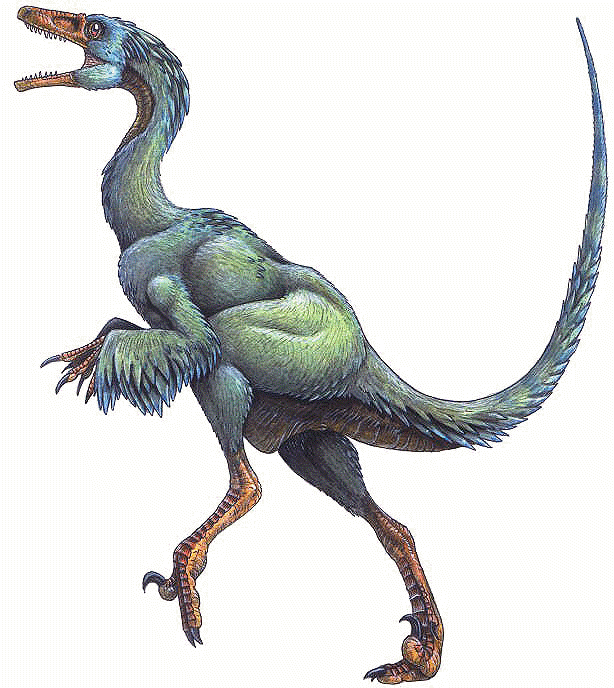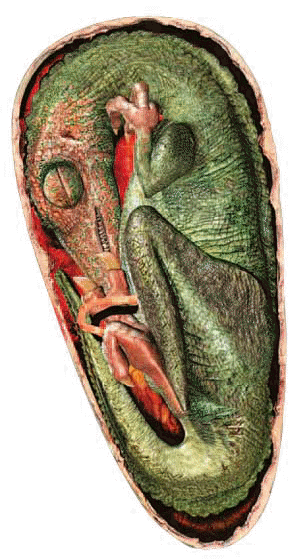|

|
|
Troodon formosus
(Joseph Leidy,
1856; Sauvage, 1876) |
|
Not on the poster |
|
 |
|
Name Means: |
"Tooth that wounds" |
Length: |
6 feet (3 m) |
|
Pronounced: |
True-don |
Weight: |
110 pounds (50 kilos) |
|
When it lived: |
Late Cretaceous - 67 MYA |
|
|
|
Where found: |
Montana, USA; Alberta, Canada |
|
|
|
Troodon was a small dinosaur, only about 6 feet
long, but he had a very large brain compared to his body size.
Some scientists think that the was the smartest of all the dinosaurs.
It's eyes were large suggesting nocturnal activity they faced slightly
forward facing, giving it some depth perception.
Troodon had very long, slender limbs suggesting that it was a fast
runner.
Troodon is Greek for "wounding tooth", and refers to
the dinosaur's sharp teeth with serrated edges. Although originally
thought to be a predator, there is some evidence that Troodon
may either have been an omnivore or an herbivore. The teeth are short
but broad, and have large serrations like those of herbivorous
dinosaurs; their sides show signs of wear. The jaws meet in a
broad, U-shaped symphysis similar to that of an iguana. Its diet
may have consisted of smaller animals, including mammals and perhaps a
significant amount of plant material.
Its long arms that folded back like a birds', and its hands
possessed partially opposable thumbs. It had large, sickle-shaped
claws on its second toes which were raised off the ground when
running. This claw is common in the
superfamily Maniraptora, to which Troodon belongs. Although no
feathers have been found, Troodon was descended from
Sinornithoides
who did have them. Paleontologists believe that Troodon
inherited the feature and was covered with them
Prior to 1983 Troodon was a mystery to paleontologists. The
first scientifically studied dinosaurs were discovered in England
during the early part of the 19th century. By 1842 (the year Richard
Owen first proposed the name Dinosauria) several species of these
Mesozoic giants were known from fragmentary fossils. About a
decade later, in 1855, Ferdinand V. Hayden collected some fossils at
the confluence of the Judith and Missouri Rivers in Montana while on a
geological survey. The fossils, which included an assortment of
species, were among the first American dinosaur fossils. He
forwarded them to Joseph Leidy at the Academy of Natural Sciences in
Philadelphia. Leidy was one of the great American scientists of
the 19th-Century and is best known as the Father of American
Vertebrate Paleontology. The species contained an interesting
tooth. Leidy though it was from a previously unknown lizard and
gave it the name Troodon, possibly because of its worn condition. It
was later reclassified as a plant eating dinosaur now known as the
stegosaurus, but other scientists assigned to various groups
carnivorous dinosaurs.
In 1983, paleontologist Phil Currie stumbled across a jawbone
containing the mystery teeth while walking in the Alberta badlands
near the Royal Tyrrell Museum where he works. It was the link he
needed to build a theory of what the Troodon looked like when it
roamed the earth 75-million years ago. Currie then determined that the Troodon would have been about 45
kilograms, six feet in length and particularly suited to running.
"The legs were relatively long, and the lower parts of the leg were
especially elongated. We walk on the flats of our feet, but
troodontids stood on their toes like most other dinosaurs. However
only two toes actually touched the ground when this animal was
running," In fact the Troodon's foot structure, as well as its
posture and brain indicate that it was very birdlike. Many scientists
believe it was covered in feathers. Currie published his finding
in his book, A
Moment in Time with Troodon.
Additional specimens have been found in Montana and Wyoming.
Today Troodon is one of the most well known dinosaurs, with over
20 known specimens. |
Fossil nests
found at the famous "Egg Mountain" site in Montana contained
elongated eggs that were originally attributed to the small plant-eating hypsilophodont Orodromeus.
They have been reidentified as nests belonging to Troodon.
Full preparation of an embryo revealed
a baby Troodon inside one of them. A recently
discovered nest included partial remains of an adult Troodon
that may have been brooding the eggs, much in the manner of the
meat-eating dinosaur Oviraptor. Troodon
produced two large eggs at a time, perhaps daily
or at longer intervals over a period of weeks, and used and soil
and direct body contact to incubate the clutch in an open nest --
there is no evidence of accumulated plant material at the known
nest sites. |
 |
|
Courtesy DK
Publishing |
|
|
|
|
|
|
|
|
Edugraphics.Net | Feenixx Publishing |
|
|
|
| | |
![]()

